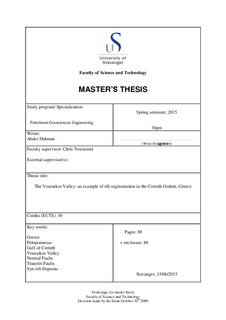| dc.contributor.author | Dahman, Abder | |
| dc.date.accessioned | 2015-09-17T08:27:44Z | |
| dc.date.available | 2015-09-17T08:27:44Z | |
| dc.date.issued | 2015-06 | |
| dc.identifier.uri | http://hdl.handle.net/11250/300404 | |
| dc.description | Master's thesis in Petroleum geosciences engineering | nb_NO |
| dc.description.abstract | The Gulf of Corinth is recognized as one of the most active rift systems in the world, the study area covers an onshore rift section on the southern flank of the gulf, the northern part of Peloponnesus. The area comprises inactive faults in the south and currently active faults on the north. The rift initiated 5 Ma, and has undergone several acceleration in the extension rate, northward fault migration, uplift and erosion. The deeply cut NNE Vouraikos Valley provide an exceptional study area of early rifting, sun-rift infill and normal faulting. North dipping faults with an overall east-west trend, dipping 40-50⁰, these normal fault has been described as continuous faults, traced from tip to tip point across the Vouraikos Valley, but fault investigation in the valley proved the opposite, there are several faults that terminates in the valley, such as Kerpini- and Dhoumena Fault that shows several hundreds of meters of fault displacement on the west, though on the east valley side there are no evidence for these major faults are crossing. Further faults show stepping in the valley and vertically displacement of the basement rock. However the northernmost faults, Mamosia Pirghaki-, Dhervini- and East Eliki Fault shows no sign of stepping in the valley, but these faults may all be currently active and these may yet to be further displaced. Transfer fault has been assigned the study area to explain the abrupt discontinuity of the faults across the valley, high angle fault underlying the valley structure, allowing the extension to be transferred between two adjacent normal fault that are undergoing differential displacement and strain. A three dimensional structural model of the area is presented to illustrate how the fault blocks interact with each other and shows the effect of transfer faults. | nb_NO |
| dc.description.sponsorship | Total, Lundin | nb_NO |
| dc.language.iso | eng | nb_NO |
| dc.publisher | University of Stavanger, Norway | nb_NO |
| dc.relation.ispartofseries | Masteroppgave/UIS-TN-IPT/2015; | |
| dc.subject | petroleumsteknologi | nb_NO |
| dc.subject | petroleum engineering | nb_NO |
| dc.subject | petroleumsgeologi | nb_NO |
| dc.subject | structural geology | nb_NO |
| dc.subject | geomodelling | nb_NO |
| dc.subject | petroleum geosciences engineering | nb_NO |
| dc.subject | Gulf of Corinth | |
| dc.title | The Vouraikos Valley: an example of rift segmentation in the Corinth Graben, Greece | nb_NO |
| dc.type | Master thesis | nb_NO |
| dc.subject.nsi | VDP::Technology: 500::Rock and petroleum disciplines: 510::Geological engineering: 513 | nb_NO |
| dc.subject.nsi | VDP::Mathematics and natural science: 400::Geosciences: 450::Petroleum geology and petroleum geophysics: 464 | |
| dc.source.pagenumber | 88 | nb_NO |
